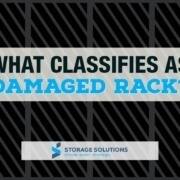There is no other way to say it: safety in a warehouse setting comes at a premium. Creating a safe working atmosphere in a warehouse requires awareness, diligence, and a knowledge of how your operations can lend themselves to accidents and wear and tear of equipment that can make your racking unsafe over time.
Luckily, National Safety Month serves as a helpful reminder to take a step back and evaluate your people, equipment, and facility to ensure that processes are in place that provide safety to the best of your ability. Looking at your layout and evaluating any damage in your warehouse can lead to a safer work environment for you and your team.
At Storage Solutions, we utilize the Rack Manufacturers Institute (RMI) ‘Guideline for the Assessment and Repair of Damaged Pallet Rack’ & recommendations from our rack manufacturer partners to determine if the rack is damaged to the point where it needs to be repaired or replaced.
What Classifies as Damaged Uprights?
Forklifts cause the majority of instances of damaged uprights. While there are plenty of safety solutions designed to prevent damage caused by forklift impact, accidents still occur. Warehouse layouts can be unfriendly to forklift operators in the sense that there are many tight corners, lots of activity, and – let’s face it – there is the danger that comes with transporting heavy objects.
In terms of looking for damage, the best place to start is at the bottom of the upright columns. We typically look at any dent larger than 1/8 of an inch on the front of an upright or ¼ of an inch on the side of an upright as damaged. There are times when you can continue to operate with some less severe dents, but if welds are broken or twisted, then the rack should be addressed through repair or replacement.
What Classifies as Damaged Beams?
Forklifts can also damage horizontal beams – if a forklift accidentally impacts the beam with a fork or perhaps a pallet was not appropriately aligned and knocked on the beam. Overloaded beams can cause damage as well when items that are heavier than the beam’s capacity rating are placed in the pallet rack.
In evaluating beam damage, we usually first look at the beam when loaded with a product. Per RMI engineering standards, beams are only allowed to bend (or deflect) a certain amount. If beam deflection exceeds the allowable amount, the rack has likely been overloaded & those beams should be considered damaged & replaced. If the beam continues to bend when the product is removed, then we also consider that beam to be damaged and should be replaced.
What Should I Do About Damaged Rack?
There are other causes of damage to racking that should be evaluated as well. For instance, in temperature-controlled storage, racks may develop rust that can degrade the storage capacity on both the uprights and beams. There are several variables to consider, and damage frequency is dependent on factors from the layout of the facility to how well or often drivers are trained.
In another blog, we break down the decision of whether you should replace or repair your damaged racking. There are many variables in that decision, including whether you can pause your operations for repair, the degree to which the rack has been damaged, and then evaluating your options in terms of cost between new and used uprights or beams.
To learn more about safety products, procedures, or if you are interested in learning more about how to handle your damaged pallet rack, contact us today. Our team is ready to learn more about your needs, and we can connect you with the best solution to keep your equipment and warehouse safe.



